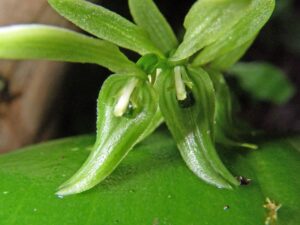How to Propagate Acianthera aberrans

Propagating Acianthera aberrans: A Guide for Orchid Enthusiasts
Introduction:
Acianthera aberrans, sometimes called the "Wandering Acianthera" (though this common name is not universally used and may be applied to other similar species), is a captivating miniature orchid appreciated for its delicate, often pendulous growth habit and charming inflorescences. Its relatively small size and ease of culture (once established) make it a desirable addition to any orchid collection, especially for those with limited space. However, propagation can present some unique challenges. Its popularity among orchid enthusiasts stems from its beauty and the satisfaction derived from successfully cultivating and propagating this species. This guide will explore the various propagation methods for Acianthera aberrans, outlining the processes, challenges, and rewards.
Seed Germination:
Currently, there are no known reliable methods for seed germination propagation of Acianthera aberrans. Orchid seeds, including those of Acianthera species, are notoriously minute and require a symbiotic relationship with specific fungi (mycorrhizae) for successful germination. Replicating this symbiotic relationship in a laboratory setting is complex and often necessitates specialized equipment and expertise typically found only in research facilities or advanced orchid nurseries. Therefore, seed germination is not a practical method for home propagators.
Cuttings:
Cuttings are not a viable propagation method for Acianthera aberrans. Unlike some other plants, orchids, particularly those in the genus Acianthera, do not readily root from stem cuttings. Attempts to propagate through this method usually result in the decay of the cuttings due to susceptibility to fungal and bacterial infections.
Division:
Division is the most practical and successful method for propagating Acianthera aberrans. This involves carefully separating the plant into smaller sections, each containing several pseudobulbs and roots.
Challenges: The main challenge lies in ensuring each division has a sufficient root system to support its independent growth. Overly aggressive division can weaken the plants, leading to stress and potential loss.
Practical Tips: The ideal time for division is during the active growing season when new growth is evident. Use a sharp, sterile instrument to divide the plant. Ensure each division has several healthy pseudobulbs and a good root system. Plant the divisions in a well-draining orchid potting mix. Handle the plants gently to avoid damaging roots and pseudobulbs.
Rewards: Division offers a straightforward method to increase the number of plants, allowing for sharing and expansion of your collection. It’s also a relatively low-risk method compared to other propagation techniques, yielding quick results.
Tissue Culture:
Tissue culture is a potentially viable method, though it requires specialized equipment, sterile conditions, and a deep understanding of plant tissue culture techniques.
Challenges: Establishing sterile conditions and preparing the correct growth medium are significant hurdles. Contamination by bacteria or fungi can quickly ruin the entire culture. The procedures necessitate specialized expertise and equipment, making it impractical for most home hobbyists.
Practical Tips: For successful tissue culture, one needs to employ aseptic techniques, and a well-equipped laboratory, supplemented by a suitable nutrient medium. Protocols specific to Acianthera aberrans are not widely published and would likely need to be developed through experimentation.
Rewards: Tissue culture offers the potential for large-scale propagation and the creation of disease-free clones. This method potentially allows for the preservation of rare or endangered varieties.
Conclusion:
Propagating Acianthera aberrans presents unique challenges. While seed germination and cuttings are not viable, division offers a relatively straightforward way for home orchid enthusiasts to increase their collection. Tissue culture holds significant potential for large-scale propagation but requires specialized skills and equipment. The success of any method hinges on careful attention to detail and a thorough understanding of the plant’s needs. The reward for successfully propagating Acianthera aberrans lies not just in expanding your orchid collection but in the satisfaction of mastering a challenging horticultural process. The dedication required emphasizes the unique bond that forms between grower and plant, making the achievement all the more rewarding. Ultimately, for the average orchid hobbyist, mastering division is the key to successfully propagating this lovely miniature orchid.